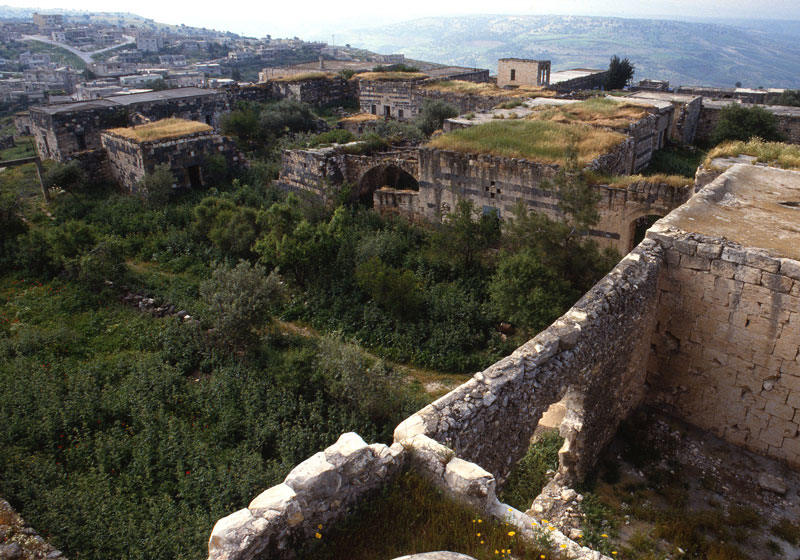Roman Relics
The road to Um Qais sits on a natural viaduct passing westwards, with the Yarmouk Valley to its north and Wadi Al Arab to its south. Twenty minutes after leaving Irbid, the landscape starts to get more rugged, with large stretches of white rocks penetrated by big oak trees gradually filling the scene. On both sides of the road, occasional glimpses of deeper valleys can be seen. Just before entering the modern village that appears as a whitish foreground of ever-unfinished, iron-bar-prickly architecture, the historical site appears in the background as a watercolor in dusty gold doted with silver-blue basalt.

The building housing the Um Qais museum building shapes most of the historical skyline, furnishing it with the powerful profile of a square dome. The building’s position on the highest point of the late 19th century village, and at its northeastern corner, give the museum a stunning presence; announcing one's arrival at the historical site from quite a distance.
The museum building was the house of the Rusan family. It is the only structure in traditional Um Qais that has an extensive second floor, giving is the grandeur appropriate to the office that the owner once held as "kaymaqam" (local governor), towards the end of the Ottoman period. Like the rest of the village, this building sits on the foundation of the Greco-Roman acropolis. Travelers’ accounts tell us that until the 1890's no houses were built on the hill, and local villagers were living in the beautifully built mausoleums and tombs, many still accessible, on the hillside to the east. The date of construction, therefore, can be given as shortly before the end of the 19th century. Entering the building, it becomes clear that there were different phases of construction, basically between 1890s and 1930s, as seen by the different treatment of stone and architectural details. The construction periods were followed by relative stability until Israeli planes bombed the upper floor in 1967.
By the late 1980s the structure was still inhabited by elder members of the Rusan family, and in the following years the building, with the rest of traditional Um Qais, were abandoned. Restoration works started immediately, in 1988-1989, and was based on minimal intervention, keeping the rural spirit of the place, and concentrating on consolidation and the service of the new function.
Both inside and outside rooms on the ground floor, and a display of Roman statues and artifacts, show a perfect harmony between the high-art of the 2,000-year-old Roman Empire and the simple, but pleasant, East-Mediterranean architecture of the late Ottoman period. Some of the most soothing aspects of this style of architecture are the transitional spaces between interiors and courtyards as created by the vaulted ewans. These spaces are basically rooms with ceilings of cross-vaults, with the side facing the courtyard kept fully open. Besides providing a smooth transition from inner spaces to the outside, these features provide an room ideal for living with the outside temperature in a mild climate such as Jordan’s.

In the most beautiful of these spaces –the old Madafa- sits the statue of Tyche, the city goddess of Gadara. In 1989, upon completion of restoration work, this statue was brought to the building from the western theater, to protect it from the sun, rain and other hazards. The headless Tyche sits on a chair, both carved from one slab of imported marble weighing several tons. This fragile sculpture was shipped, two millennia ago, across the Mediterranean Sea, Palestine, the Jordan Valley, and up a slope some 600-metres to arrive here at Roman Gadara.
With its pomegranate courtyard, marble statues, mosaic panels and basalt sarcophagi, Um Qais museum stands as an edifice with layers of history. The elegant architecture of its rooms and courtyards provides a relaxing experience, and from a staircase facing the headless Tyche you can ascend to a lofty terrace overlooking Lake Tiberias.
The museum of Um Qais remains one of Jordan’s precious jewels; it is a place of elegance, tranquility and simplicity.
To get to Um Qais drive to Irbid, avoid the city-centre by driving around the city from the east. You might need to ask for directions more than once or you will end up exploring Irbid without meaning to - never mind that Irbid is, or rather was, also one of the Decapolis. One-way drive should take slightly less than two hours. A full-day destination, Um Qais (Gadara) can be combined with other sites of the ten Roman Cities - the Decapolis- such as Bait Ras, Quailbeh or Pella. Driving on to Mukhaybeh or Himmeh is also a good idea. This destination is suitable for children, as the Um Qais restaurant provides good meals and a suitable resting place.